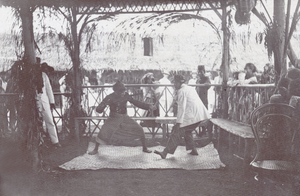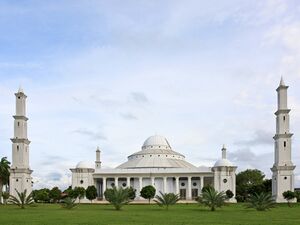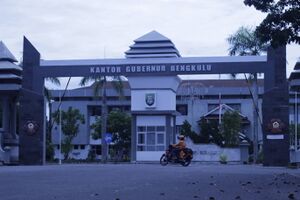بنغكولو
Bengkulu | |
|---|---|
| Province of Bengkulu | |
| الكنية: | |
| الشعار: Sekundang Setungguan Seio Sekato (Bengkulu) (Many hands make the works lighter) | |
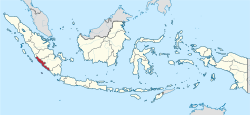 | |
| Established | 18 November 1968 |
| Capital and largest city | Bengkulu |
| الحكومة | |
| • الكيان | Bengkulu Provincial Government |
| • Governor | Rohidin Mersyah |
| • Vice Governor | Rosjonsyah Syahili |
| المساحة | |
| • الإجمالي | 19٬919٫33 كم² (7٬690٫90 ميل²) |
| ترتيب المساحة | 28th in Indonesia |
| أعلى منسوب | 2٬852 m (9٬357 ft) |
| التعداد (mid 2022 estimate) | |
| • الإجمالي | 2٬060٬092 |
| • الترتيب | 26th in Indonesia |
| • الكثافة | 100/km2 (270/sq mi) |
| [1] | |
| Demographics | |
| • Ethnic groups | Rejang (60,4%), الجاويون (22,3%), Serawai (17,9%), Lembak (4,9%), Pasemah (4,4%), ميناڠكاباو (4,3%), ملايو (3,6%), سوندانيون (3%), Batak (2%) خطأ استشهاد: إغلاق </ref> مفقود لوسم <ref> |
| HDI rank | 18th in Indonesia (2023)[2] |
| الموقع الإلكتروني | bengkuluprov |
بڠكولو أو بنجكولو (وتُعرف أيضاً بإسم جنوب غرب سومطرة) هي إحدى مقاطعات إندونسيا وتقع على الساحل الجنوبي الغربي لجزيرة سومطرة. It was formed on 18 November 1968 by separating out the area of the historic Bencoolen Residency from the province of South Sumatra under Law No. 9 of 1967 and was finalized by Government Regulation No. 20 of 1968. Spread over 20,130.21 km2, it is bordered by the provinces of West Sumatra to the north, Jambi to the northeast, Lampung to the southeast, and South Sumatra to the east, and by the Indian Ocean to the northwest, south, southwest, and west.
Bengkulu is the 28th largest province by area; it is divided into nine regencies and the city of Bengkulu, the capital and the only independent city. Bengkulu is also the 26th largest province by population in Indonesia, with 1,715,518 inhabitants at the 2010 Census[3] and 2,010,670 at the 2020 Census;[4] the official estimate as at mid 2022 was 2,060,092.[1] According to a release by Badan Pusat Statistik, it has the eleventh highest Human Development Index among the provinces, with a score of about 0.744 in 2013. By 2014, the province is positioned 28th highest in gross domestic product and 20th highest in life expectancy, 70.35 years.
Bengkulu also includes offshore Mega Island and Enggano Island in the Indian Ocean. Bengkulu has 525 kilometres of coastline along the Indian Ocean on its western side, from Dusun Baru Pelokan in Mukomuko Regency to Tebing Nasal in Kaur Regency. Bengkulu has many natural resources such as coal and gold, and has big and potential geothermal resources.[5][6] However, it is less developed than other provinces in Sumatra.
أصل الاسم
Traditional sources suggest that the name Bengkulu or Bangkahulu derived from the word bangkai and hulu which means 'carcasses located in a stream'. According to the story, there was once a war between small kingdoms in Bengkulu, resulting in many casualties from both sides in the streams of Bengkulu. These casualties soon rotted as they were not buried, lying in river streams. This etymology is similar to the story of a war between the Majapahit Empire and the Pagaruyung Kingdom in Padang Sibusuk, an area once ruled by the Dharmasraya empire, which also derives the name Padang Sibusuk from casualties rotting on the battlefield. During the European colonial era, the region was known as Bencoolen or British Bencoolen.[7][8]
التاريخ
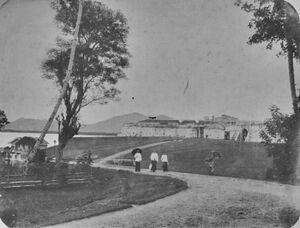
The region was subject to the Buddhist Srivijaya empire in the 8th century. The Shailendra Kingdom and Singosari Kingdom succeeded the Srivijaya but it is unclear whether they spread their influence over Bengkulu. The Majapahit also had little influence over Bengkulu.[9] There were only few smalls ‘kedatuan’ based on ethnicity such as in Sungai Serut, Selebar, Pat Petulai, Balai Buntar, Sungai Lemau, Sekiris, Gedung Agung and Marau Riang. It became a vassal region of the Banten Sultanate (from Western Java) in the early 15th century[9] and since the 17th century was ruled by Minangkabau's Inderapura Sultanate (today's in Pesisir Selatan, West Sumatra Province).
The first European visitors to the area were the Portuguese, followed by the Dutch in 1596. The British East India Company established a pepper-trading center and garrison at Bengkulu (Bencoolen) in 1685.[10] In 1714 the British built Fort Marlborough, which still stands. The trading post was never profitable for the British, being hampered by a location which Europeans found unpleasant, and by an inability to find sufficient pepper to buy.[بحاجة لمصدر] It became an occasional port of call for the EIC's East Indiamen.
In 1785, the area was integrated into British Empire as Bencoolen, while the rest of Sumatra and most of the Indonesian archipelago was part of the Dutch East Indies. Sir Stamford Raffles was stationed as Lieutenant-Governor of Bencoolen (the colony was subordinate at the time to the Bengal Presidency) from 1818 to 1824, enacting a number of reforms including the abolition of slavery, and the British presence left a number of monuments and forts in the area. Despite the difficulties of keeping control of the area while Dutch colonial power dominated the rest of Sumatra, the British persisted, maintaining their presence for roughly 140 years before ceding Bengkulu to the Dutch as part of the Anglo-Dutch Treaty of 1824 in exchange for Malacca.[11] Bengkulu then remained part of the Dutch East Indies until the Japanese occupation in World War 2.
During the early 1930s, Sukarno, the future first president of Indonesia, was imprisoned by the Dutch and briefly resided in Bengkulu,[12] where he met his wife, Fatmawati. The couple had several children, including Megawati Sukarnoputri, who later became Indonesia's first female President.
After independence, Bengkulu was initially part of the 'South Sumatra' Province, which also included Lampung, the Bangka-Belitung Islands, and what is now South Sumatra itself, as a Residency. In 1968, Bengkulu gained provincial status, becoming the 26th province of Indonesia, preceding East Timor.
Bengkulu lies near the Sunda Fault and is prone to earthquakes and tsunamis. The June 2000 Enggano earthquake killed at least 100 people. A recent report predicts that Bengkulu is "at risk of inundation over the next few decades from undersea earthquakes predicted along the coast of Sumatra"[13] A series of earthquakes struck Bengkulu during September 2007, killing 13 people.[14]
الجغرافيا والمناخ
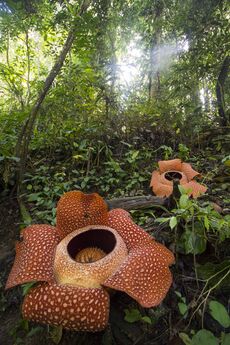
The western part of Bengkulu province, bordering the Indian Ocean coast, is about 576 km along, and the eastern part of the condition is hilly with a plateau that is prone to erosion. Bengkulu Province is on the west side of the Bukit Barisan mountains. The province's area is about 20,130.21 square kilometres,or slightly smaller than the European country,Slovenia.The province extends from the border province of West Sumatra to the border province of Lampung; the distance is about 567 kilometres. Bengkulu Province lies between 2° 16' S and 03° 31' S latitude and 101° 01'-103° 41'E longitude.[15] Bengkulu province in the north borders the province of West Sumatra, in the southern the Indian Ocean and Lampung province, in the west it borders the Indian Ocean and in the east the provinces of Jambi and South Sumatra. Bengkulu province is also bordered by the Indian Ocean coastline of approximately 525 kilometres to the west. Its western part is hilly with fertile plateaus, while the western part is lowland relatively narrow, elongated from north to south and punctuated bumpy areas.
Bengkulu's climate is classified as tropical. Bengkulu has a large amount of rainfall throughout the year, even in the driest month. The climate here is classified as Af by the Köppen-Geiger system. The annual average temperature is 26.8 °C. The average annual rainfall is 3360 mm.
The total area of Bengkulu province is 20,130.21 km2. For administrative purposes, the province is divided into nine regencies and one city, together sub-divided into 93 districts.[16]
| بيانات المناخ لـ Bengkulu (Fatmawati Soekarno Airport, 1991–2020 normals) | |||||||||||||
|---|---|---|---|---|---|---|---|---|---|---|---|---|---|
| الشهر | ينا | فب | مار | أبر | ماي | يون | يول | أغس | سبت | أكت | نوف | ديس | السنة |
| القصوى القياسية °س (°ف) | 33.7 (92.7) |
35.2 (95.4) |
34.4 (93.9) |
34.8 (94.6) |
35.4 (95.7) |
34.9 (94.8) |
35.0 (95.0) |
33.9 (93.0) |
34.0 (93.2) |
33.9 (93.0) |
33.8 (92.8) |
34.0 (93.2) |
35.4 (95.7) |
| متوسط القصوى اليومية °س (°ف) | 31.0 (87.8) |
31.3 (88.3) |
31.5 (88.7) |
31.5 (88.7) |
31.8 (89.2) |
31.6 (88.9) |
31.3 (88.3) |
31.2 (88.2) |
31.2 (88.2) |
31.1 (88.0) |
30.9 (87.6) |
30.6 (87.1) |
31.2 (88.2) |
| المتوسط اليومي °س (°ف) | 25.6 (78.1) |
25.8 (78.4) |
26.0 (78.8) |
26.3 (79.3) |
26.3 (79.3) |
26.0 (78.8) |
25.6 (78.1) |
25.5 (77.9) |
25.6 (78.1) |
25.6 (78.1) |
25.6 (78.1) |
25.4 (77.7) |
25.8 (78.4) |
| متوسط الدنيا اليومية °س (°ف) | 22.3 (72.1) |
22.3 (72.1) |
22.3 (72.1) |
22.5 (72.5) |
22.5 (72.5) |
22.3 (72.1) |
22.0 (71.6) |
22.0 (71.6) |
22.1 (71.8) |
22.3 (72.1) |
22.3 (72.1) |
22.3 (72.1) |
22.3 (72.1) |
| الصغرى القياسية °س (°ف) | 20.5 (68.9) |
20.2 (68.4) |
20.4 (68.7) |
20.5 (68.9) |
20.3 (68.5) |
20.5 (68.9) |
19.8 (67.6) |
19.5 (67.1) |
18.1 (64.6) |
20.5 (68.9) |
20.3 (68.5) |
20.8 (69.4) |
18.1 (64.6) |
| متوسط تساقط الأمطار mm (inches) | 287.9 (11.33) |
222.8 (8.77) |
259.5 (10.22) |
241.1 (9.49) |
171.7 (6.76) |
133.9 (5.27) |
146.8 (5.78) |
155.4 (6.12) |
147.8 (5.82) |
210.7 (8.30) |
328.8 (12.94) |
359.9 (14.17) |
2٬666٫3 (104.97) |
| Average precipitation days (≥ 1.0 mm) | 16.5 | 13.7 | 15.4 | 13.9 | 10.7 | 9.2 | 8.6 | 9.1 | 9.3 | 13.1 | 17.0 | 19.3 | 155.8 |
| Mean monthly ساعات سطوع الشمس | 127.0 | 133.9 | 153.8 | 163.8 | 179.7 | 175.7 | 182.9 | 185.3 | 155.0 | 136.7 | 120.3 | 111.4 | 1٬825٫5 |
| Source: World Meteorological Organization[17] | |||||||||||||
التعداد
| السنة | تعداد | ±% |
|---|---|---|
| 1971 | 519٬316 | — |
| 1980 | 768٬064 | +47.9% |
| 1990 | 1٬179٬122 | +53.5% |
| 1995 | 1٬409٬117 | +19.5% |
| 2000 | 1٬567٬436 | +11.2% |
| 2010 | 1٬715٬518 | +9.4% |
| 2015 | 1٬872٬136 | +9.1% |
| 2020 | 2٬010٬670 | +7.4% |
| 2022 | 2٬060٬092 | +2.5% |
| Source: Badan Pusat Statistik 2019-2023 | ||
The 2010 census reported a population of 1,715,518[3] including 875,663 males and 837,730 females;[18] by the 2020 Census this had risen to 2,010,670,[4] and the official estimate for mid 2022 was 2,060,092.[1]
الجماعات العرقية
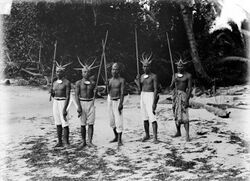
Bengkulu is home to various indigenous ethnic groups. The Rejangs form the majority of the province with 60,4% of the population. The second largest ethnic group is the Javanese forming around 24%. Other minority indigenous ethnic groups includes Lembak, Serawai, Pekal, Enggano, Pasemah, Minangkabau and Malays. There is also non-indigenous ethnic groups that mostly came from other parts of Indonesia such as Sundanese, Javanese, Acehnese, Madurese, Batak, Chinese and others.
الدين
The 2022 data of Ministry of Religious Affairs found 97.69% of the population as adherents to Islam and 2% as Christian. The remainder includes Hindus (0.20%) who are mostly Balinese migrants, Buddhists (0.1%), and "other" including traditional beliefs (0.004%).[19]
اللغات
Like the rest of Indonesia, Indonesian is the official language for formal occasions, institutions, and government affairs while local languages are widely used in daily life.
Most indigenous languages in Bengkulu belong to the Malayan group of Austronesian languages, such as Bengkulu Malay, Lembak, Pekal and Minangkabau varieties. The most widely spoken language in the province, Rejang, is the only Bornean language to be spoken in Sumatra (and one of three outside of Borneo other than Malagasy in Madagascar and Yakan in Basilan).
Engganese is classified as a highly divergent branch of Malayo-Polynesian, however, this is still debated.[بحاجة لمصدر][من؟]. A less-studied language is Nasal language, which may be related to Rejang or form its own branch of Malayo-Polynesian. Non-indigenous ethnic groups also speak their own language/dialects.
الأقسام الإدارية
When it was formed in 1967 from the western parts of South Sumatra province, Bengkulu Province consisted of three regencies - Bengkulu Selatan, Bengkulu Utara and Rejang Lbong - together with the independent city of Bengkulu, which lies outside any regency. Five additional regencies were established on 25 February 2003 - Kaur Regency and Seluma Regency from parts of Bengkulu Selatan, Kepahiang Regency and Lebong Regency from parts of Rejand Lrbong Regency, and Mukomuko Regency from part of Bengkulu Utara. A ninth regency (Bengkulu Tengah) was formed on 24 June 2008 from another part of Bengkulu Utara. The regencies and city are listed below with their areas and their populations at the 2010[3] and 2020[4] Censuses, together with the official estimates as at mid 2022.[1]
| الاسم | المساحة (كم2) | التعداد تقدير 2005 |
التعداد تعداد 2010 |
العاصمة |
|---|---|---|---|---|
| بڠكولو (مدينة) | 144.52 | 257,763 | 308,756 | بڠكولو |
| South Bengkulu Regency (Bengkulu Selatan) | 1,179.65 | 129,878 | 142,722 | Manna |
| Rejang Lebong Regency | 1,475.99 | 237,459 | 246,378 | Curup |
| North Bengkulu Regency (Bengkulu Utara) | 5,548.54 | 328,620 | 256,358 | Argamakmur |
| Kaur Regency | 2,369.05 | 106,184 | 107,627 | Bintuhan |
| Seluma Regency | 2,400.44 | 156,814 | 172,801 | Pasar Tais |
| موكوموكو Regency | 4,036.70 | 130,401 | 156,312 | موكوموكو |
| Lebong Regency | 1,929.24 | 85,850 | 97,091 | Tubei |
| Kepahiang Regency | 704.57 | 113,317 | 125,011 | Kepahiang |
| Central Bengkulu Regency (Bengkulu Tengah) | * | * | 98,570 | Karang Tinggi |
- # المساحة والتعداد المقدّر في 2005 من Central Bengkulu Regency مدمجة في الأرقام for North Bengkulu Regency.
الاقتصاد
Three active coal mining companies produce between 200,000 and 400,000 tons of coal per year, which is exported to Malaysia, Singapore, South Asia, and East Asia.[بحاجة لمصدر] Fishing, particularly tuna and mackerel, is an important activity.[بحاجة لمصدر] Agricultural products exported by the province include ginger, bamboo shoots, and rubber.[بحاجة لمصدر]
انظر أيضاً
الهامش
- ^ أ ب ت ث Badan Pusat Statistik, Jakarta, 2023, Provinsi Bengkulu Dalam Angka 2023 (Katalog-BPS 1102001.17)
- ^ "Indeks Pembangunan Manusia Menurut Provinsi, 1996–2013". Retrieved 5 May 2016.
- ^ أ ب ت Biro Pusat Statistik, Jakarta, 2011.
- ^ أ ب ت Badan Pusat Statistik, Jakarta, 2021.
- ^ EJOLT. "Bengkulu Coal-fired Power Plant, Indonesia | EJAtlas". Environmental Justice Atlas (in الإنجليزية). Retrieved 2023-04-26.
- ^ Sari, Meri Maya (2017-04-21). "Kajian Efektivitas Pelaksanaan Amdal Bidang Energi Dan Sumber Daya Mineral Dalam Pelestarian Kawasan Lindung di Kabupaten Bengkulu Tengah". Jurnal Pengelolaan Sumberdaya Alam Dan Lingkungan (Journal of Natural Resources and Environmental Management). 7 (1): 61–71. doi:10.29244/jpsl.7.1.61-71. ISSN 2086-4639.
- ^ "A History on the Honourable East India Company's Garrison on the West Coast of Sumatra 1685–1825". Retrieved May 10, 2016.
- ^ "Bencoolen (Bengkulen)". Retrieved May 10, 2016.
- ^ أ ب Schellinger, Paul; Salkin, Robert, eds. (1996). International Dictionary of Historic Places, Volume 5: Asia and Oceania. Chicago: Fitzroy Dearborn Publishers. p. 113. ISBN 1-884964-04-4.
- ^ "Bencoolen, Fort Marlborough of the East India Company". wftw.nl. Retrieved 2023-04-26.
- ^ Roberts, Edmund (1837). Embassy to the Eastern Courts of Cochin-China, Siam, and Muscat. New York: Harper & Brothers. p. 34.
- ^ "Indonesia - Toward independence | Britannica". www.britannica.com (in الإنجليزية). Retrieved 2023-04-26.
- ^ Andrew C. Revkin (2006-12-05). "Indonesian Cities Lie in Shadow Of Cyclical Tsunami". The New York Times (Late Edition (East Coast)) p. A.5.
- ^ "With Every Rumble, Indonesians Fear Additional Ruin (Published 2007)". The New York Times. Archived from the original on 2019-08-23.
- ^ "Bengkulu | province, Indonesia | Britannica". www.britannica.com (in الإنجليزية). Retrieved 2023-04-26.
- ^ "SEKILAS BENGKULU". PEMERINTAH PROVINSI BENGKULU (in الإندونيسية). Retrieved 2023-04-26.
- ^ "World Meteorological Organization Climate Normals for 1991–2020". World Meteorological Organization. Retrieved 19 October 2023.
- ^ "Jumlah Penduduk Bengkulu 1,7 Juta Jiwa | Harian Berita Sore". Archived from the original on 2011-07-07. Retrieved 2010-08-31.
- ^ "Jumlah Penduduk Menurut Agama" (in الإندونيسية). Ministry of Religious Affairs. 31 August 2022. Archived from the original on 9 July 2023. Retrieved 29 October 2023.
- CS1 الإندونيسية-language sources (id)
- Short description is different from Wikidata
- Pages using infobox settlement with possible nickname list
- Pages using infobox settlement with possible motto list
- Pages using infobox settlement with missing country
- Pages using infobox settlement with no coordinates
- Articles with unsourced statements from January 2013
- Articles with unsourced statements from April 2020
- جميع المقالات الحاوية على عبارات مبهمة
- جميع المقالات الحاوية على عبارات مبهمة from April 2020
- Pages with empty portal template
- بڠكولو
- مستعمرات بريطانية سابقة
- أماكن مأهولة تأسست في 1685
- مقاطعات إندونيسيا
- Indonesia–United Kingdom relations
- States and territories established in 1967
- صفحات مع الخرائط





